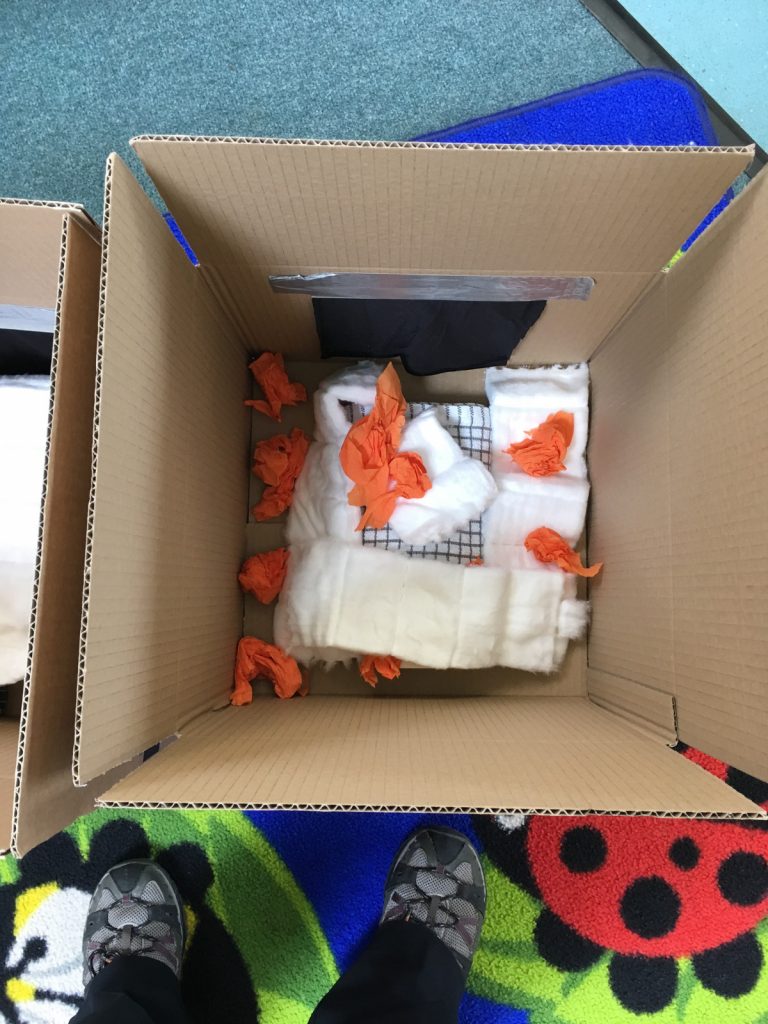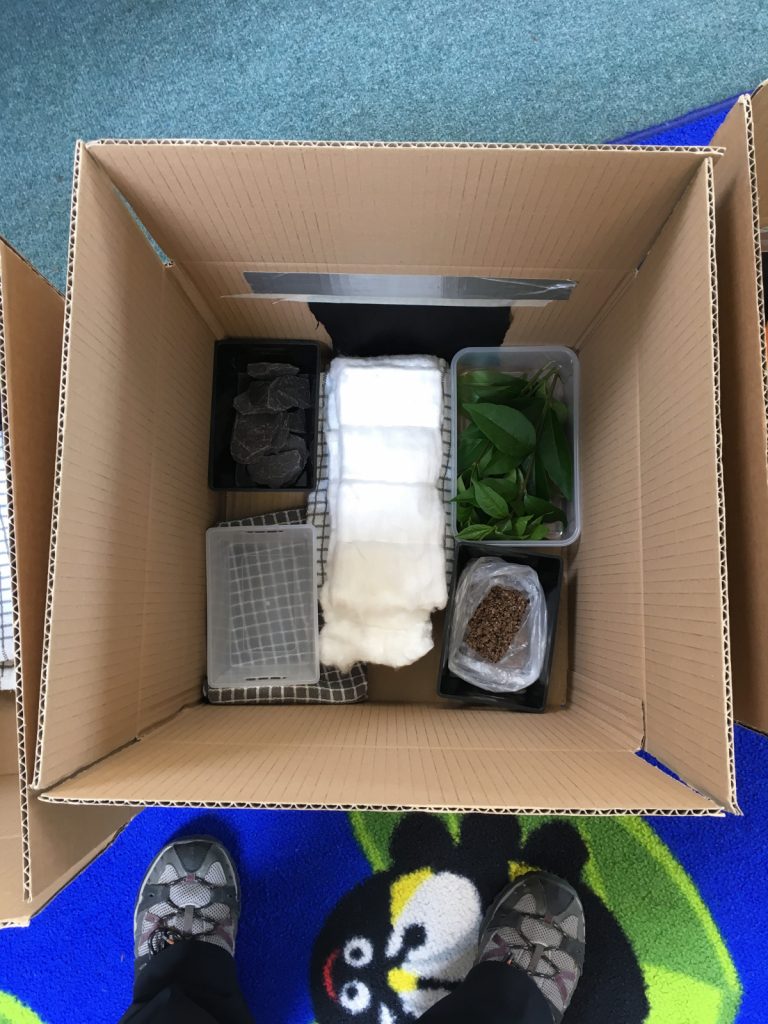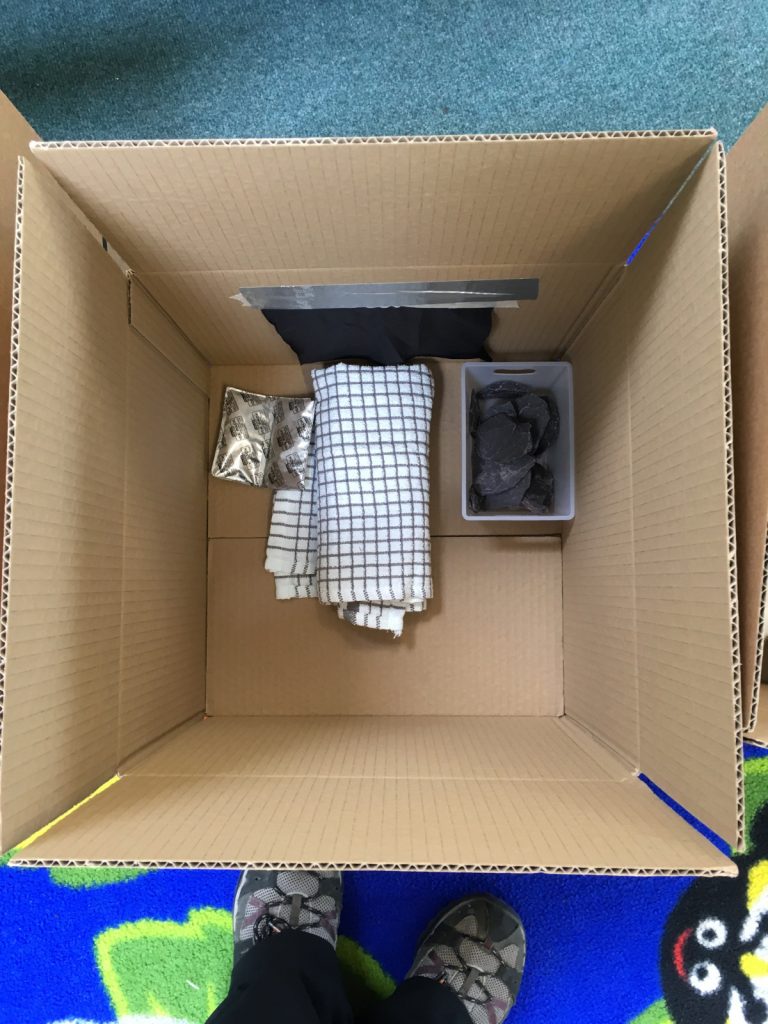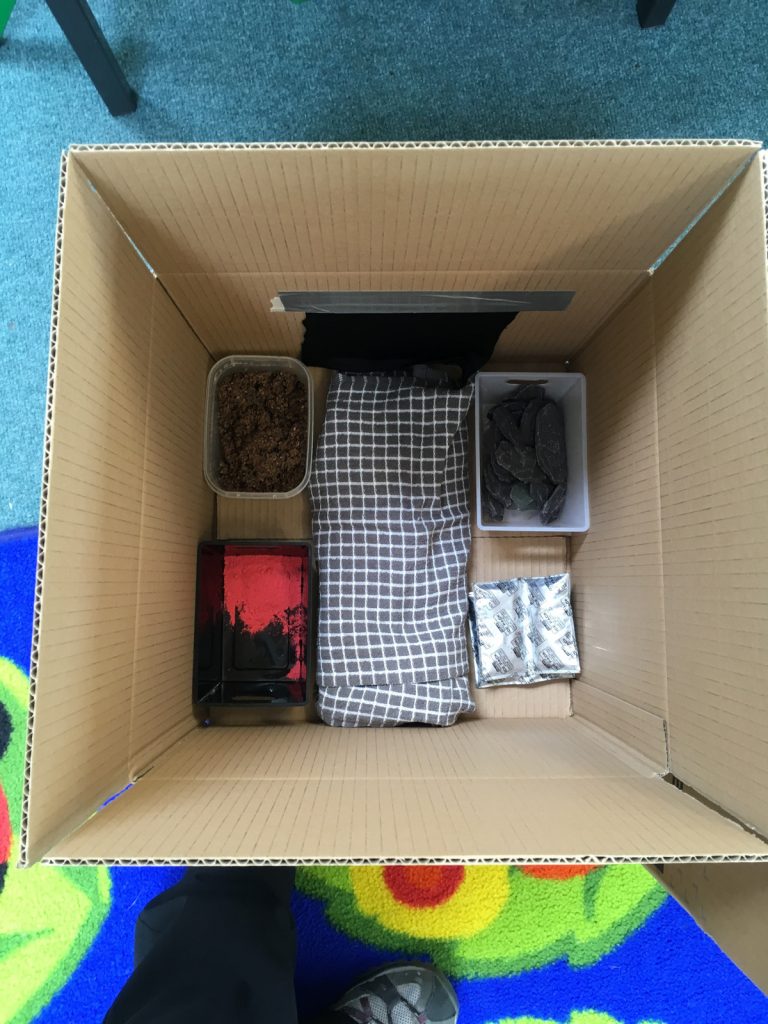Summary | Key concept | Science Story | Background Science | Activity | Curriculum links | Linked Activities
- Suggested Age Range: 4 – 5 years; 5 – 6 years
- UK Primary Curriculum: EYFS (Reception); Key Stage One
- Suggested UK Year Group: EYFS (Reception); Year 1
- UK EYFS Curriculum Link: Understanding the World
- UK Primary Curriculum Link: Y1 – Everyday materials
- Science Subject: The Sun, the Moon and the Earth
- Science Question: What are the Sun, Moon and Earth made of?
- Activity type: small group
- Suggested linked stories: Paddling to the Moon; A Rope to the Moon; Travelling to the Moon; A Ladder to the Moon
Brief summary: This activity uses touch boxes to illustrate some important characteristics of some Solar System objects and the differences between them. Children will be able to sense the differences in materials between several solar system bodies using everyday items as an analogy. This activity uses simple, easy to source materials, but the boxes do need to be assembled in advance.
Key concept: The Sun and the planets are all different, each has different unique properties.
Key words: Sun, planet, hot, cold, rock, gas, clouds, hard, soft
Visuals: This activity uses flash cards. Download them as a Word document or as a PDF file. At the end of this file you can also find the flash cards without vocabulary (so that you can optionally add your own words).
The Science Story:
When we look at the Sun and the Moon, do they look the same?
No, they look very different!
How are they different?
The Sun is really bright, and it looks yellow. The Moon is grey and not as bright.
Can you think of any other differences?
The Moon changes shape, sometimes it is round, sometimes it is a half-Moon, and sometimes it looks like a banana (this shape is called a crescent Moon).
Does the Sun change shape like the Moon?
No, the Sun is always a circle.
What do you think the Moon is made of?
The Moon is made of rocks, just like the Earth, but the Moon is colder than the Earth so there is no air, no water, and no seas, oceans or rivers. It is so dry that there is no life, no plants, no fish, no animals.
The Sun is very different. The Sun is not made of rock, it is made of gas (like the air) but is much hotter than the Moon or the Earth. It is so hot on the Sun that water would boil.
So the Moon is too cold, and the Sun is too hot.
What about our planet, the Earth?
The Earth has rocks like the Moon. The Earth is cooler than the Sun, and warmer than the Moon, so water on the Earth does not boil or freeze, and we have oceans, seas and rivers full of life.
There are eight planets in the Solar System (Mercury, Venus, Earth, Mars, Jupiter, Saturn, Uranus and Neptune), and they are all very different.
The Science: Below are descriptions of several solar system objects which you may find useful in leading discussions with the students doing the activity. The flash cards (Word document, PDF file) have suggested vocabulary that can be used to describe each planet, of you can use the versions included in this file to add your own vocabulary.
The Sun is perhaps the most familiar astronomical object. At the centre of our solar system, it is the source of all the heat and light that gives our planet the perfect conditions for life. The temperature on the surface of the Sun is 6000oC, more than 20 times hotter that a hot oven. Unlike the Earth, the Sun is made of gas and has no solid surface. In the touch box, the hot water bottle is used to represent the high temperature, and the cotton wool represents the gaseous nature of the Sun.
The Earth is our planet, our home in the solar system. It is the third planet from the Sun and is the only place in the solar system where we know liquid water exists. To illustrate this, the touch box contains some rock to represent the surface, some mud or wet sand to represent the liquid water and ground. It is also the only place known to support life in the solar system, so the touch box contains some plant life to illustrate this point. A small amount of cotton wool can also be included to represent our atmosphere and clouds.
The Moon is our companion in the solar system. Like the Earth, it has a solid surface (represented by rocks), but since it is much smaller than the Earth is does not have enough gravity to keep hold of an atmosphere. This lack of atmosphere means that the Moon cannot keep hold of the heat received from the Sun, so the surface is much colder than the Earth, represented by a frozen ice block. The surface of the Moon is rocky with large amounts of fine dust that has been created in by millions of meteorite impacts over the 4.5-billion-year lifetime of the Moon, represented here by small rocks and sand.
The planet Mars is a rocky planet like the Earth. Is has a solid rocky surface, represented by the rocks. Since it is further from the Sun than the Earth, the temperature on Mars is lower and water only exists as ice, represented by ice cubes (or an ice block if you prefer). This idea of it being cooler the further you get from the Sun can be illustrated by asking the students how warm they feel close to, and then further away from a radiator. Mars is known as the Rad Planet since it has a distinctly orange appearance in the sky. This colour is due to a high level of iron in the surface rock, the colour can be represented using some orange powder paint, or a rusty object (but take care with sharp edges). Mars has a thin atmosphere, and again this can be represented by a small amount of cotton wool.
Jupiter is the largest planet in the solar system. Unlike the planets described above, Jupiter is a type of planet known as a gas giant. It is made of gas rather than rock and has no solid surface. This is represented here by a large mound of cotton wool to illustrate a gas atmosphere. Since it is a long way from the Sun (Jupiter is more than five times as far from the Sun as the Earth) it is very cold, again represented by an ice block at the bottom of the touch box.
Other solar system object are of course possible. You can find a huge amount of information on the planets and their characteristics on the NASA, ESA or National Geographic websites, or in any good space encyclopaedia.
The activity: The touch boxes can be constructed using shoe boxes or similar. Cut a hole in each box big enough for someone to fit their hand through. If you have time, you can fix some dark fabric inside the box, covering the hole so that students cannot see into the box – this can be effective and add to the excitement, but is not necessary. Assemble the boxes in advance, and print off the flash cards (Word document, PDF file, or see below) with the object picture, and descriptive keywords underneath.
Students can then take it in turns to put a hand inside the box and describe what they feel. This activity works well in small groups, where the students each feel inside the box, describe to the other students what they feel, and then decide between them which Solar System object the box represents. The activity can be concluded with a whole-class discussion on what they found in the boxes, and whether they all agreed on the answers.
Props required: Sense boxes could be constructed from shoe boxes, office moving boxes, or similar. The items used to represent each solar system body could be for example:
- Sun: hot water bottle covered with a mound of cotton wool to illustrate hot gas.
- Earth: water, mud, moss, to represent sea, ground and life respectively.
- Moon: blue ice block (as used in cool boxes), small rocks or pebbles, plus fine sand to illustrate cold, rocky surface.
- Mars: rock and orange powder paint to represent rocky orange surface, add ice to show Mars is colder than the Earth.
- Jupiter: blue ice block with mound of cotton wool to illustrate a cold gas giant.
- Flash cards (Word document, PDF file, or see below).
Safety note: Consider wrapping the hot water bottle and ice blocks in a tea towel or similar to avoid pupils touching the hot/cold surfaces directly.
- This is a group activity, so find a few friends to work with.
- With your friends, sit around a table with a Touch Box in the middle.
- Take it in turns to put a hand into the box and (carefully!) feel inside.
- What can you feel? Tell your friends what you feel: is it hot or cold? Are there rocks? What else can you feel?
- Look at the picture cards of the Sun, Moon, Earth and other planets, and read the words that go with the pictures.
- Talk to your friends and decide which Solar System object it represents.
- Move on to the next table with a different box, and repeat the experiment.
The image gallery below shows the interiors of boxes made up to represent the Sun, Earth, Moon and Mars. Note that hot water bottles and ice blocks are wrapped in tea towels to protect the skin of participants. When in use, the top of the box is also closed, and participants put their hands through the hole covered by black cloth (this can be seen at the top of each image).
Extension: Other solar system objects are of course possible. You can find a huge amount of information on the planets and their characteristics on the NASA or ESA websites, or in any good space encyclopaedia. In the classroom, you can ask the students what other planets they could make from the materials available. A longer extension would be to research other environments using books or the internet and design their own touch boxes for their friends to guess.
Common misconceptions:
- The Sun is a planet – it is not a planet, it is a star and is several thousand degrees on the surface.
- The Moon is a planet – it is not a planet, it is rocky like the Earth, but it is in fact a satellite, revolving around the Earth.
- All the planets are like the Earth – in fact they are all quite different. Planets closer to the Sun are much warmer, those further away are much colder, and not all of the planets have a solid surface.
- The planets emit light – planets actually emit no light of their own, the light we see from the planets is actually reflected sunlight.
Curriculum links:
- Everyday materials: exploring what the Sun, Earth and Moon are made of in terms of simple everyday items
- Geography: understanding the Earth
- English KS1: building vocabulary, descriptive words, descriptive language
SEND notes: this activity relies on touch so works well without modification with visually impaired students. Visual flashcards can be modified for 3D printed tactile versions.
Use with other years:
- Use with EYFS as part of understanding the world. A simpler version of this activity suitable for EYFS Reception is to just use the Sun, Earth and Moon, and make up three boxes for each group within the class. Instead of using flash cards, optionally students can be encouraged to use vocabulary to describe what they feel.
- Use with year 5/6 to design their own touch boxes by researching the conditions of each body using secondary sources to explore the solar system. They can then try out their touch boxes with younger children to see how well they work.
Linked activities:
Fruit Solar System demonstration, from the Royal Observatory Greenwich: https://www.stem.org.uk/rxyx3
Know Your Planets card game, can be used as an introductory or follow-on activity to provide more information on the different planets and their characteristics – astroEDU: https://astroedu.iau.org/en/activities/1615/know-your-planets/
Additional resources:
A more detailed description of the planets from National Geographic: https://www.nationalgeographic.com/science/space/our-solar-system/
Another source of information about the planets from NASA: https://solarsystem.nasa.gov/planets/overview/
A battery-powered solar system model (or orrery) or sale from the Science Museum: https://shop.sciencemuseum.org.uk/exhibition-ranges/wonderlab-collection/wonderlab-space/motorized-solar-system.htm
Copyright: Megan Argo 2019

